Roberto Martín-Martín
Mixed-Initiative Dialog for Human-Robot Collaborative Manipulation
Aug 07, 2025Abstract:Effective robotic systems for long-horizon human-robot collaboration must adapt to a wide range of human partners, whose physical behavior, willingness to assist, and understanding of the robot's capabilities may change over time. This demands a tightly coupled communication loop that grants both agents the flexibility to propose, accept, or decline requests as they coordinate toward completing the task effectively. We apply a Mixed-Initiative dialog paradigm to Collaborative human-roBot teaming and propose MICoBot, a system that handles the common scenario where both agents, using natural language, take initiative in formulating, accepting, or rejecting proposals on who can best complete different steps of a task. To handle diverse, task-directed dialog, and find successful collaborative strategies that minimize human effort, MICoBot makes decisions at three levels: (1) a meta-planner considers human dialog to formulate and code a high-level collaboration strategy, (2) a planner optimally allocates the remaining steps to either agent based on the robot's capabilities (measured by a simulation-pretrained affordance model) and the human's estimated availability to help, and (3) an action executor decides the low-level actions to perform or words to say to the human. Our extensive evaluations in simulation and real-world -- on a physical robot with 18 unique human participants over 27 hours -- demonstrate the ability of our method to effectively collaborate with diverse human users, yielding significantly improved task success and user experience than a pure LLM baseline and other agent allocation models. See additional videos and materials at https://robin-lab.cs.utexas.edu/MicoBot/.
Casper: Inferring Diverse Intents for Assistive Teleoperation with Vision Language Models
Jun 17, 2025Abstract:Assistive teleoperation, where control is shared between a human and a robot, enables efficient and intuitive human-robot collaboration in diverse and unstructured environments. A central challenge in real-world assistive teleoperation is for the robot to infer a wide range of human intentions from user control inputs and to assist users with correct actions. Existing methods are either confined to simple, predefined scenarios or restricted to task-specific data distributions at training, limiting their support for real-world assistance. We introduce Casper, an assistive teleoperation system that leverages commonsense knowledge embedded in pre-trained visual language models (VLMs) for real-time intent inference and flexible skill execution. Casper incorporates an open-world perception module for a generalized understanding of novel objects and scenes, a VLM-powered intent inference mechanism that leverages commonsense reasoning to interpret snippets of teleoperated user input, and a skill library that expands the scope of prior assistive teleoperation systems to support diverse, long-horizon mobile manipulation tasks. Extensive empirical evaluation, including human studies and system ablations, demonstrates that Casper improves task performance, reduces human cognitive load, and achieves higher user satisfaction than direct teleoperation and assistive teleoperation baselines.
SLAC: Simulation-Pretrained Latent Action Space for Whole-Body Real-World RL
Jun 07, 2025Abstract:Building capable household and industrial robots requires mastering the control of versatile, high-degree-of-freedom (DoF) systems such as mobile manipulators. While reinforcement learning (RL) holds promise for autonomously acquiring robot control policies, scaling it to high-DoF embodiments remains challenging. Direct RL in the real world demands both safe exploration and high sample efficiency, which are difficult to achieve in practice. Sim-to-real RL, on the other hand, is often brittle due to the reality gap. This paper introduces SLAC, a method that renders real-world RL feasible for complex embodiments by leveraging a low-fidelity simulator to pretrain a task-agnostic latent action space. SLAC trains this latent action space via a customized unsupervised skill discovery method designed to promote temporal abstraction, disentanglement, and safety, thereby facilitating efficient downstream learning. Once a latent action space is learned, SLAC uses it as the action interface for a novel off-policy RL algorithm to autonomously learn downstream tasks through real-world interactions. We evaluate SLAC against existing methods on a suite of bimanual mobile manipulation tasks, where it achieves state-of-the-art performance. Notably, SLAC learns contact-rich whole-body tasks in under an hour of real-world interactions, without relying on any demonstrations or hand-crafted behavior priors. More information, code, and videos at robo-rl.github.io
DataMIL: Selecting Data for Robot Imitation Learning with Datamodels
May 14, 2025Abstract:Recently, the robotics community has amassed ever larger and more diverse datasets to train generalist robot policies. However, while these policies achieve strong mean performance across a variety of tasks, they often underperform on individual, specialized tasks and require further tuning on newly acquired task-specific data. Combining task-specific data with carefully curated subsets of large prior datasets via co-training can produce better specialized policies, but selecting data naively may actually harm downstream performance. To address this, we introduce DataMIL, a policy-driven data selection framework built on the datamodels paradigm that reasons about data selection in an end-to-end manner, using the policy itself to identify which data points will most improve performance. Unlike standard practices that filter data using human notions of quality (e.g., based on semantic or visual similarity), DataMIL directly optimizes data selection for task success, allowing us to select data that enhance the policy while dropping data that degrade it. To avoid performing expensive rollouts in the environment during selection, we use a novel surrogate loss function on task-specific data, allowing us to use DataMIL in the real world without degrading performance. We validate our approach on a suite of more than 60 simulation and real-world manipulation tasks - most notably showing successful data selection from the Open X-Embodiment datasets-demonstrating consistent gains in success rates and superior performance over multiple baselines. Our results underscore the importance of end-to-end, performance-aware data selection for unlocking the potential of large prior datasets in robotics. More information at https://robin-lab.cs.utexas.edu/datamodels4imitation/
BiFlex: A Passive Bimodal Stiffness Flexible Wrist for Manipulation in Unstructured Environments
Apr 11, 2025Abstract:Robotic manipulation in unstructured, humancentric environments poses a dual challenge: achieving the precision need for delicate free-space operation while ensuring safety during unexpected contact events. Traditional wrists struggle to balance these demands, often relying on complex control schemes or complicated mechanical designs to mitigate potential damage from force overload. In response, we present BiFlex, a flexible robotic wrist that uses a soft buckling honeycomb structure to provides a natural bimodal stiffness response. The higher stiffness mode enables precise household object manipulation, while the lower stiffness mode provides the compliance needed to adapt to external forces. We design BiFlex to maintain a fingertip deflection of less than 1 cm while supporting loads up to 500g and create a BiFlex wrist for many grippers, including Panda, Robotiq, and BaRiFlex. We validate BiFlex under several real-world experimental evaluations, including surface wiping, precise pick-and-place, and grasping under environmental constraints. We demonstrate that BiFlex simplifies control while maintaining precise object manipulation and enhanced safety in real-world applications.
Why Automate This? Exploring the Connection between Time Use, Well-being and Robot Automation Across Social Groups
Jan 10, 2025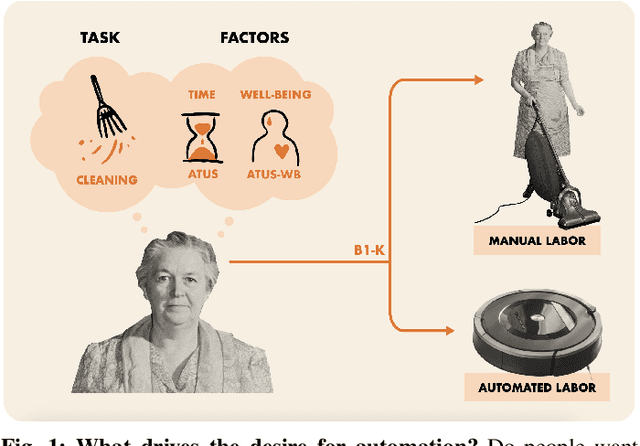
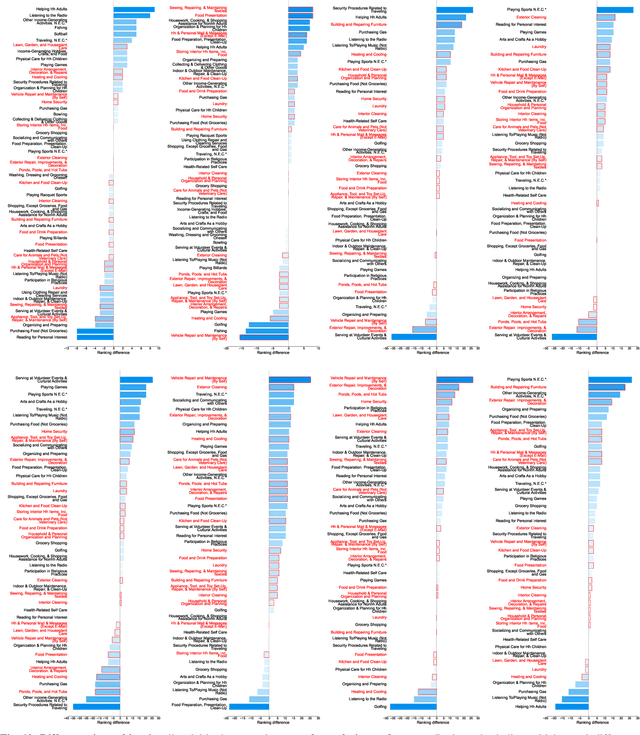
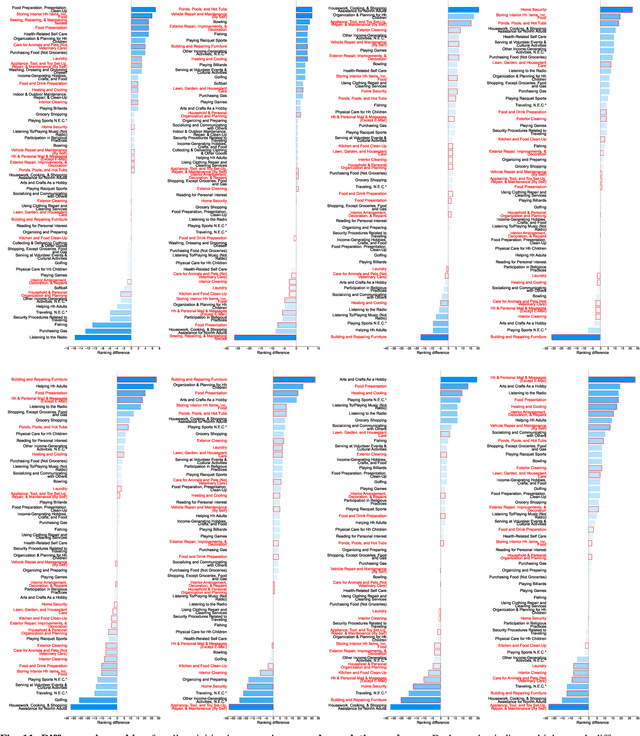
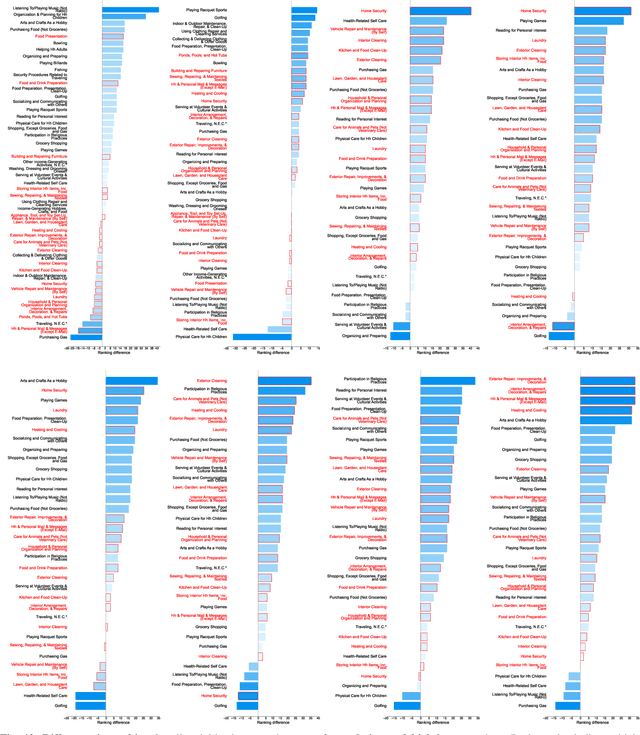
Abstract:Understanding the motivations underlying the human inclination to automate tasks is vital to developing truly helpful robots integrated into daily life. Accordingly, we ask: are individuals more inclined to automate chores based on the time they consume or the feelings experienced while performing them? This study explores these preferences and whether they vary across different social groups (i.e., gender category and income level). Leveraging data from the BEHAVIOR-1K dataset, the American Time-Use Survey, and the American Time-Use Survey Well-Being Module, we investigate the relationship between the desire for automation, time spent on daily activities, and their associated feelings - Happiness, Meaningfulness, Sadness, Painfulness, Stressfulness, or Tiredness. Our key findings show that, despite common assumptions, time spent does not strongly relate to the desire for automation for the general population. For the feelings analyzed, only happiness and pain are key indicators. Significant differences by gender and economic level also emerged: Women prefer to automate stressful activities, whereas men prefer to automate those that make them unhappy; mid-income individuals prioritize automating less enjoyable and meaningful activities, while low and high-income show no significant correlations. We hope our research helps motivate technologies to develop robots that match the priorities of potential users, moving domestic robotics toward more socially relevant solutions. We open-source all the data, including an online tool that enables the community to replicate our analysis and explore additional trends at https://hri1260.github.io/why-automate-this.
SkiLD: Unsupervised Skill Discovery Guided by Factor Interactions
Oct 24, 2024
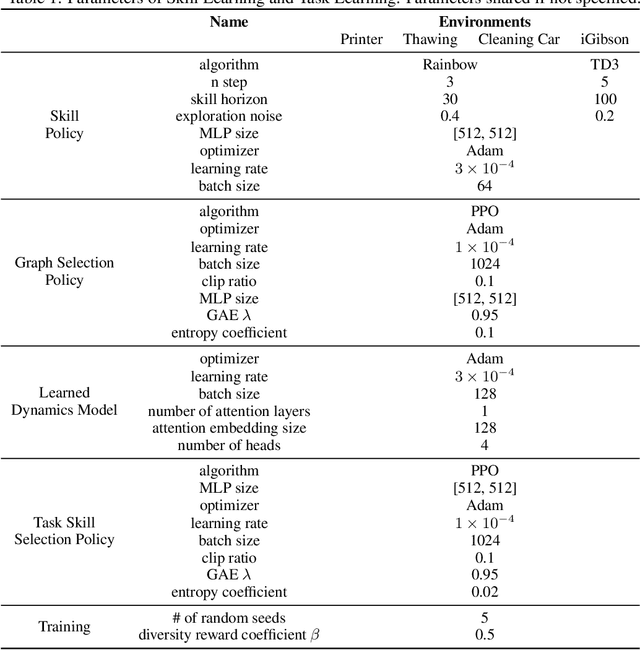
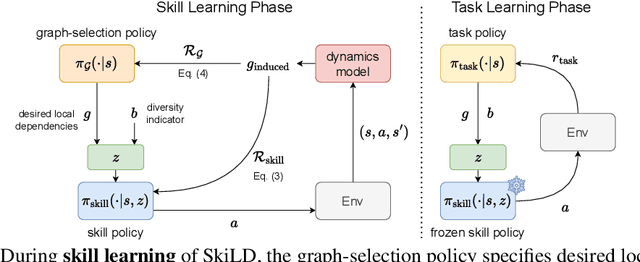

Abstract:Unsupervised skill discovery carries the promise that an intelligent agent can learn reusable skills through autonomous, reward-free environment interaction. Existing unsupervised skill discovery methods learn skills by encouraging distinguishable behaviors that cover diverse states. However, in complex environments with many state factors (e.g., household environments with many objects), learning skills that cover all possible states is impossible, and naively encouraging state diversity often leads to simple skills that are not ideal for solving downstream tasks. This work introduces Skill Discovery from Local Dependencies (Skild), which leverages state factorization as a natural inductive bias to guide the skill learning process. The key intuition guiding Skild is that skills that induce <b>diverse interactions</b> between state factors are often more valuable for solving downstream tasks. To this end, Skild develops a novel skill learning objective that explicitly encourages the mastering of skills that effectively induce different interactions within an environment. We evaluate Skild in several domains with challenging, long-horizon sparse reward tasks including a realistic simulated household robot domain, where Skild successfully learns skills with clear semantic meaning and shows superior performance compared to existing unsupervised reinforcement learning methods that only maximize state coverage.
Learning to Look: Seeking Information for Decision Making via Policy Factorization
Oct 24, 2024



Abstract:Many robot manipulation tasks require active or interactive exploration behavior in order to be performed successfully. Such tasks are ubiquitous in embodied domains, where agents must actively search for the information necessary for each stage of a task, e.g., moving the head of the robot to find information relevant to manipulation, or in multi-robot domains, where one scout robot may search for the information that another robot needs to make informed decisions. We identify these tasks with a new type of problem, factorized Contextual Markov Decision Processes, and propose DISaM, a dual-policy solution composed of an information-seeking policy that explores the environment to find the relevant contextual information and an information-receiving policy that exploits the context to achieve the manipulation goal. This factorization allows us to train both policies separately, using the information-receiving one to provide reward to train the information-seeking policy. At test time, the dual agent balances exploration and exploitation based on the uncertainty the manipulation policy has on what the next best action is. We demonstrate the capabilities of our dual policy solution in five manipulation tasks that require information-seeking behaviors, both in simulation and in the real-world, where DISaM significantly outperforms existing methods. More information at https://robin-lab.cs.utexas.edu/learning2look/.
Disentangled Unsupervised Skill Discovery for Efficient Hierarchical Reinforcement Learning
Oct 15, 2024



Abstract:A hallmark of intelligent agents is the ability to learn reusable skills purely from unsupervised interaction with the environment. However, existing unsupervised skill discovery methods often learn entangled skills where one skill variable simultaneously influences many entities in the environment, making downstream skill chaining extremely challenging. We propose Disentangled Unsupervised Skill Discovery (DUSDi), a method for learning disentangled skills that can be efficiently reused to solve downstream tasks. DUSDi decomposes skills into disentangled components, where each skill component only affects one factor of the state space. Importantly, these skill components can be concurrently composed to generate low-level actions, and efficiently chained to tackle downstream tasks through hierarchical Reinforcement Learning. DUSDi defines a novel mutual-information-based objective to enforce disentanglement between the influences of different skill components, and utilizes value factorization to optimize this objective efficiently. Evaluated in a set of challenging environments, DUSDi successfully learns disentangled skills, and significantly outperforms previous skill discovery methods when it comes to applying the learned skills to solve downstream tasks. Code and skills visualization at jiahenghu.github.io/DUSDi-site/.
BUMBLE: Unifying Reasoning and Acting with Vision-Language Models for Building-wide Mobile Manipulation
Oct 08, 2024



Abstract:To operate at a building scale, service robots must perform very long-horizon mobile manipulation tasks by navigating to different rooms, accessing different floors, and interacting with a wide and unseen range of everyday objects. We refer to these tasks as Building-wide Mobile Manipulation. To tackle these inherently long-horizon tasks, we introduce BUMBLE, a unified Vision-Language Model (VLM)-based framework integrating open-world RGBD perception, a wide spectrum of gross-to-fine motor skills, and dual-layered memory. Our extensive evaluation (90+ hours) indicates that BUMBLE outperforms multiple baselines in long-horizon building-wide tasks that require sequencing up to 12 ground truth skills spanning 15 minutes per trial. BUMBLE achieves 47.1% success rate averaged over 70 trials in different buildings, tasks, and scene layouts from different starting rooms and floors. Our user study demonstrates 22% higher satisfaction with our method than state-of-the-art mobile manipulation methods. Finally, we demonstrate the potential of using increasingly-capable foundation models to push performance further. For more information, see https://robin-lab.cs.utexas.edu/BUMBLE/
 Add to Chrome
Add to Chrome Add to Firefox
Add to Firefox Add to Edge
Add to Edge